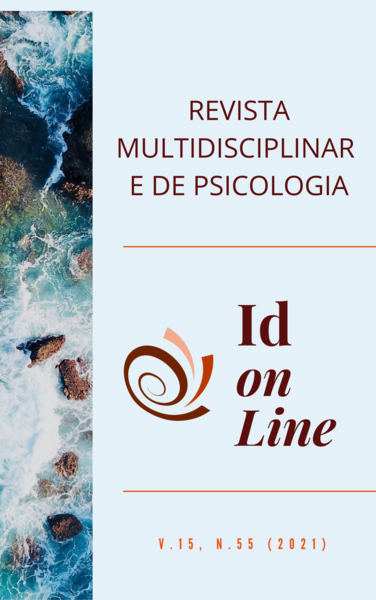Instrumento de Avaliação da ansiedade acadêmica no Ensino Superior em Biologia / Academic Anxiety Assessment Instrument in Higher Education in Biology
DOI:
https://doi.org/10.14295/idonline.v15i55.3051Palavras-chave:
Ansiedade, Ensino Superior, PsicometriaResumo
Este é um estudo transversal observacional que objetiva a construção de um questionário para a identificação de indivíduos com ansiedade relacionada à graduação em Ciências Biológicas no contexto brasileiro. Formou-se um grupo focal para levantar as principais situações ansiosas vivenciadas no curso, o que forneceu informações para a construção de um questionário inicial, o qual foi avaliado por juízes professores e alunos do curso acerca de sua clareza e objetividade. Selecionamos 73 itens julgados melhores para o questionário aplicado a um grupo de 325 alunos. A Análise dos Componentes Principais encontrou 4 componentes que explicam a ansiedade no curso, restando 37 itens significantes: (1) 18 itens relacionados às avaliações, (2) 10 itens aos conteúdos específicos do curso, (3) 5 itens ao professor, (4) e 4 itens aos conteúdos matemáticos. A multiplicidade de componentes era esperada devido à complexidade associada à ansiedade.
Downloads
Referências
AKGUN, S.; CIARROCHI, J. Learned resourcefulness moderates the relationship between academic stress and academic performance. Educational Psychology, v. 23, n. 3, p. 287-294, 2003. https://doi.org/10.1080/0144341032000060129
AKINSOLA, E. F., NWAJEI, A. D. Test anxiety, depression and academic performance: assessment and management using relaxation and cognitive restructuring techniques. Psychology, v. 4, n. 6, p. 18-24, 2013. http://dx.doi.org/10.4236/psych.2013.46A1003
APA - AMERICAN PSYCHIATRIC ASSOCIATION. Manual diagnóstico e estatístico de transtornos mentais: texto revisado (DSM-V-TR). Porto Alegre: Artmed, 2013. ISBN 9788582710890.
ASHCRAFT, M. H. Math anxiety: Personal, educational, and cognitive consequences. Current directions in psychological science, v. 11,n. 5, p. 81–185, 2002. https://doi.org/10.1111%2F1467-8721.00196
BALDASSIN, S.; MARTINS, L. C., ANDRADE, A. G. Traços de ansiedade entre estudantes de medicina. Arquivos médicos do ABC, v. 31, n. 1, p. 27-31, 2006. https://nepas.emnuvens.com.br/amabc/article/view/232
BARDIN, L. Análise de contéudo. Lisboa: Edições 70, 2011. ISBN 9788562938047.
BERNIK, M.; et al. Transtorno de Ansiedade ao longo da vida. In FORLENZA, O.;
MIGUEL, E. C. (Ed.). Clínica psiquiátrica de bolso. São Paulo: Manole, 2014. ISBN 9788520438619.
BOWEN, C. W. Development and score validation of a chemistry laboratory anxiety instrument (CLAI) for college chemistry students. Educational and Psychological Measurement, v. 59, n.1, p.171–185, 1999. https://doi.org/10.1177%2F0013164499591012
FURNER, J. M.; BERMAN, B. T. Review of research: math anxiety: overcoming a major obstacle to the improvement of student math performance. Childhood education, v. 79, n. 3, p. 170–174, 2003. https://doi.org/10.1080/00094056.2003.10522220
GOTTFRIED, A. E. Relationships between academic intrinsic motivation and anxiety in children and young adolescents. Journal of School Psychology, v. 20, n. 3, p. 205–215, 1982. https://doi.org/10.1016/0022-4405(82)90050-4
HAMAIDEH, S. H. Stressors and reactions to stressors among university students. International journal of social psychiatry, v. 57, n. 1, p. 69–80, 2011. https://doi.org/10.1177%2F0020764009348442
HEMBREE, R. The nature, effects, and relief of mathematics anxiety. Journal for research in mathematics education, v. 21, n. 1, p. 33–46, 1990. https://doi.org/10.5951/jresematheduc.21.1.0033
IERVOLINO, S.A.; PELICIONI, M.C.F. A utilização do grupo focal como metodologia qualitativa na promoção da saúde. Revista da Escola de Enfermagem da USP, v. 35, n. 2, p. 115–121, 2001. http://dx.doi.org/10.1590/S0080-62342001000200004
KAZELSKIS, R.; et al. Mathematics anxiety and test anxiety: Separate constructs? The Journal of Experimental Education, v. 68, n. 2, p. 137–146, 2000. https://doi.org/10.1080/00220970009598499
MILGRAM, N.; TOUBIANA, Y. Academic anxiety, academic procrastination, and parental involvement in students and their parents. British Journal of Educational Psychology, v. 69, n. 3. p. 345–361, 1999. https://doi.org/10.1348/000709999157761
OTTENS, A. J. Coping with academic anxiety. New York: The Rosen Publishing Group. 1991. ISBN 0823913376.
PAPANTONIOU, G.; MORAITOU, D.; FILIPPIDOU, D. Psychometric properties of the greek version of the test anxiety inventory. Psychology, v. 2, n. 3, p. 241–247, 2011. http://dx.doi.org/10.4236/psych.2011.23038
PASQUALI, L. Análise fatorial para pesquisadores, Brasília: LabPAM, 2012. ISBN 9788565091008.
PASQUALI, L.; PRIMI, R. Fundamentos da teoria da resposta ao item: TRI. Avaliação Psicológica, v. 2, n. 2, p. 99–110, 2003. ISSN-e 2175-3431, ISSN 1677-0471.
PINTRICH, P.R.; MARX, R. W.; BOYLE, R. A. Beyond cold conceptual change: The role of motivational beliefs and classroom contextual factors in the process of conceptual change. Review of Educational research, v. 63, n.2 , p. 167–199, 1993. https://doi.org/10.3102%2F00346543063002167
PUTWAIN, D. Researching academic stress and anxiety in students: Some methodological considerations. British Educational Research Journal, v. 33, n. 2, p. 207–219, 2007. https://doi.org/10.1080/01411920701208258
RAPEE, R.M.; et al. Prevention and early intervention of anxiety disorders in inhibited preschool children. Journal of consulting and clinical psychology, v. 73, n. 3, p. 488-497, 2005. https://psycnet.apa.org/doi/10.1037/0022-006X.73.3.488
SAHIN, M.; CALISKAN, S.; DILEK, U. Development and validation of the physics anxiety rating scale. International Journal of Environmental and Science Education, v. 10, n. 2, p. 183–200, 2015. ISSN 1306-3065
YIKEALO, D.; YEMANE, B.; KARVINEN, I. The level of academic and environmental stress among college students: A case in the college of education. Open Journal of Social Sciences, v. 6, p. 40–57, 2018. https://doi.org/10.4236/jss.2018.611003Sciences, v. 6, p. 40–57, 2018
Downloads
Publicado
Como Citar
Edição
Seção
Licença
Os autores detêm os direitos autorais sem restrições, devendo informar a publicação inicial nesta revista, em caso de nova publicação de algum trabalho.










